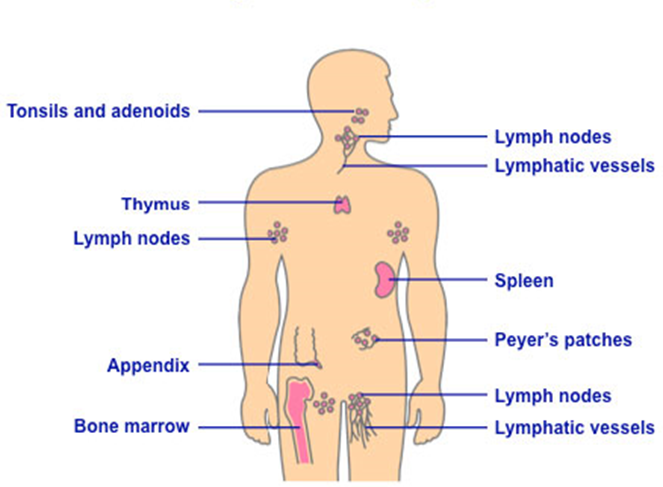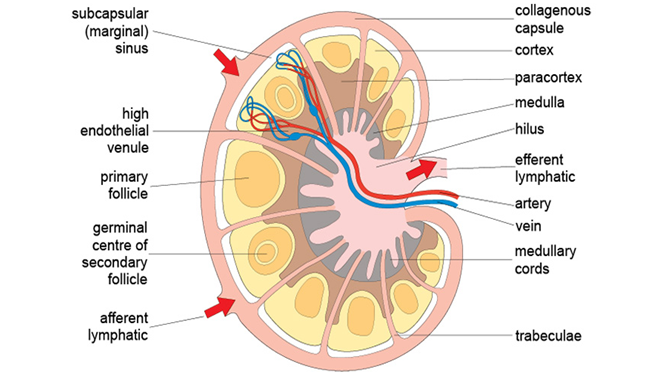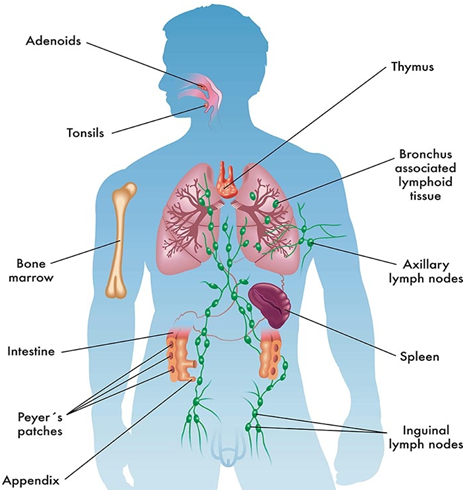The organs of the immune system are generally divided into two major groups which are the primary lymphoid organs and the secondary lymphoid organs. The bone marrow, spleen, thymus, Peyer’s patches, liver, the tonsils, the lymph nodes and several mucosal-associated lymphoid tissues (MALT) are some of the major organs or tissues that makeup the immune system of humans and other mammals. These organs play unique and various critical roles in the development of immune response against an invading pathogen or antigen; and they are specialized types of organs or tissues that makes the immunological system outstanding from other systems of the body.
Primary lymphoid organs are the central organs of the immune system; and it is in these organs that the maturation of the immune system cells (particularly the B and T lymphocytes) primarily occurs. The primary lymphoid organs primarily serve as sources of lymphocytes for other components of the immune system. Bone marrow and thymus are the two main organs that makeup the primary lymphoid organs. In the primary lymphoid organs, haematopoiesis and the generation of lymphocytes occur.
These organs are the central sites where lymphocytes (i.e. B and T cells) develop the characteristic features that typify the adaptive immune system such as discrimination between self and non-self-molecules. It is also at the primary lymphoid organs that the lymphocytes develop their first ability to specifically recognize antigens or foreign bodies that invades the body. The lymphocytes that are produced in the primary lymphoid organs are initially immature or immunocompetent cells until they become committed to a particular antigen within these organs and then transforms into immunocompetent cells with unique antigenic specificity.
Tonsils are found at the base of the tongue and at the side of the back of the mouth where they defend against pathogens that enter the body through the mouth; the adenoids are located in the nasopharyngeal roof where they defend against antigens that enter the body via the nasal passage or opening; the thymus is the organ where T cell maturation occurs after its production in the bone marrow and it is located above the heart.
The bone marrow is where B cell development and maturation as well as the development of other haematopoietic stem cells such as RBCs and WBCs occur and it is usually located in long bones of the body; lymph nodes are found all over the body especially along the junctions of the lymphatic vessels where they provide a microenvironment for the trapping, processing and presentation of antigens (trapped from regional tissue spaces in the body) to other components of the immune system.
The spleen is located at the left abdominal cavity and below the pancreas where they filter the blood to trap blood-borne pathogens (Figure 1); the peyers patches are located within the gastrointestinal tract (GIT) and even in the appendix where they provide immunological response; and the lymphatic vessels is primarily responsible for the distribution of antigens that entered the tissues to other lymphoid organs for specific immunological response.
While the development and maturation of B cells occurs in the bone marrow, the development and maturation of T cells occurs in the thymus. A lymphocyte becomes immunocompetent only when it has matured within a primary lymphoid organ (e.g. thymus and bone marrow); and immune system cells that are immunocompetent are B and T cells that has the ability to mount an immunological response against a particular antigen or pathogen in the body of an animal or mammal. Immune system cells become immunocompetent after their interaction with antigens.

The bone marrow is a yellowish-soft tissue found in all the major bones of the body (especially the long bones); and it is the primary site where all the cells of the immune system are derived from during haematopoiesis. Aside the B cells which develop and mature in the bone marrow, other cells of the immune system that develop from the bone marrow during haematopoiesis from HSCs include the progenitor T cells, mast cells, dendritic cells, NK cells, erythrocytes, platelets and granulocytes.
In neonates or foetus in utero, B cell development initially occurs in the fetal liver, fetal bone marrow or yolk sac before continuation in the adult bone marrow. In birds, B cell development and maturation occurs in the Bursa of Fabricius. After their initial development and maturation in the bone marrow, the lymphocytes leave the bone marrow to continue their maturation in the peripheral lymphoid organs (i.e. the secondary lymphoid organs).
It is noteworthy that the B cells produced during haematopoiesis of HSCs in the bone marrow are B lymphocytes that only attack non-self-molecules (i.e. antigens or pathogens). However, some B cells with specificity for self-molecules may be produced in some circumstances; and in such scenarios the clonal selection process that frequently occur in the bone marrow during haematopoiesis always ensures that B lymphocytes with self-reactive immunoglobulin receptors (i.e. B cells that attack host cells instead of antigens) are immediately eliminated. This also applies during T cell maturation in the thymus; and the process ensures that only T cells that recognize non-self-molecules are produced and propagated.
During these processes of clonal selection of T and B cells with specificity for only non-self-molecules, the lymphocytes are educated to attack only antigens and not self-molecules; and only the population of lymphocytes with antigenic specificity for foreign bodies are allowed to proliferate while those that evoke detrimental autoimmune response in the host are immediately eliminated.The bone marrow as earlier stated is the site where all the cells of the immune system originate from; and it is also responsible for the production of other important cells of the body such as platelets and RBCs.
The thymus is a bilobed endocrine gland or organ that is located above the heart; and it is the main site for the maturation of immature or progenitor T cells that emanates from the bone marrow. It is made up of two main compartments, the medulla (the inner part) and cortex (the outer part) which both contain thymocytes. Thymocytes are immature T cells of the thymus from which mature or immunocompetent T lymphocytes develop from. The major biological function of the thymus is to ensure the continuous production and selection of immunocompetent T lymphocytes that recognize and processes antigenic peptide molecules presented by or complexed with the MHC molecules.
Secondary lymphoid organs are specialized organs or tissues where lymphocytes continue their maturation after their first production in the primary lymphoid organs (e.g. bone marrow and thymus). The secondary lymphoid organs are different from the primary lymphoid organs because it is within the secondary lymphoid organs that the lymphocytes (i.e. the B and T cells) proliferate and differentiate into effector cells that actually neutralize invading pathogens or antigens.
For example, the B cells proliferate or differentiate into antibody-secreting plasma cells and memory B cells (which are the effector cells of the antibody-mediated immunity) while the T cells differentiate into effector T cells and memory T cells which are mainly responsible for cell-mediated immunity (CMI). Secondary lymphoid organs or tissues are mainly located along the vessels of the lymphatic system; and secondary lymphoid organs provide environment where effector lymphocytes interact with antigens or foreign bodies.
Lymphatic system is a series of vessels that are primarily responsible for the transportation of lymph fluids (i.e. pale-like biological liquids containing WBCs amongst other substances) from the tissues via the lymph nodes and into the entire circulation of blood in the body. The interaction of the lymphocytes with antigens within the secondary lymphoid organs leads to the differentiation of clones of lymphocytes into effector cells with unique antigenic specificity for particular antigens. The lymph nodes, spleen, and several mucosal-associate lymphoid tissues (MALT) are examples of the secondary lymphoid organs or tissues.
The secondary lymphoid organs are also sites where antigens are presented to other cells of the immune system for immunological response. The lymph nodes and the spleen are the most important secondary lymphoid organs because of the fundamental roles they play in the processing and presentation of antigens to effector lymphocytes and other cells of the immune system.
Lymph nodes are encapsulated bean-shaped lymphoid structures or tissues found throughout the body system (Figure 2); and they comprises of lymphocytes (i.e. B and T cells), macrophages and dendritic cells amongst other key immune system cells that form a mesh of immunological system. The lymph nodes generally serve as sites for the filtration of antigens from the lymph fluid or lymph prior to their presentation to immunocompetent lymphocytes and other immune system cells located within the lymph node; and the lymph nodes are richly supplied by lymphatic vessels that ensure continuous supply of lymph fluids. Lymph nodes also drain fluids from other tissues of the body especially the regional or surrounding tissue spaces aside those supplied by the lymph.
The germinal center of secondary follicle is mostly inundated with B lymphocytes. The lymph nodes are the sites where immune responses are mounted to antigenic molecules in lymph or lymph fluids; and they are mainly located at the junctions of the lymphatic vessels all over the body. The interdigitating or cellular networks formed by phagocytic cells and dendritic cells within the lymph nodes traps particulate antigens or pathogenic microorganisms that enters the lymph nodes through the lymph; and lymphocytes swim into action to mount immunological response against the trapped antigens.
The cortex, paracortex and the medulla are the three main morphological sections or parts of the lymph node (Figure 2). The cortex is the outermost part of the lymph nodes, and it is rich in macrophages, lymphocytes (particularly B cells) and dendritic cells. The paracortex underlie the cortex, and it is rich in T lymphocytes. Dendritic cells can also be found in the paracortex. The medulla is the innermost part of the lymph node, and it is sparingly populated with antibody-secreting plasma cells and other cells with lymphoid origin.

They trap foreign bodies or antigens in the process prior to returning the lymph or lymph fluids they contain or are made of to the systemic circulation. Lymphocytes in the lymph nodes become activated, proliferate and differentiate into numerous effector molecules following the invasion of antigens. After the interaction of the antigens with the macrophages or dendritic cells situated within the lymph nodes, the antigen is processed and presented to immunocompetent B and T cells for the instigation of appropriate immunological response against the pathogen.
Lymph fluids containing antigens or pathogens are brought into the lymph node via the afferent lymph duct or lymphatics of the lymph node while the efferent lymphatics is the passageway through which immunoglobulins and lymphocytes leaves the lymph nodes to the bloodstream (Figure 2). The spleen is an oval-shaped structure that is located in the upper left abdominal cavity. It is the site where antigens or pathogens are trapped from the blood circulation, and outworn RBCs are also destroyed within the spleen.
The spleen unlike the lymph nodes primarily filters the blood that passes via it and it trap antigens in the process and present them to the lymphocytes in the peripheral lymphoid tissues. It also traps antigens from other local tissues aside those carried through the blood that passes through it. Lymphocytes and blood-borne antigens are carried into the spleen via blood vessels (e.g. the spleen arteries); and the foreign bodies are presented to the lymphocytes in the process for appropriate immunological response.
Note: While the lymph nodes only trap antigens from the lymph the spleen traps antigens in the blood.The mucosal-associated lymphoid tissues (MALT) are secondary lymphoid organs or tissues that line the mucous membranes of the GIT, urogenital tract, respiratory tract and other mucous membrane surfaces that are found in the body. The primary function of MALT is to defend the mucous membranes surfaces of the body against invasion and colonization by pathogenic microorganisms or antigens.
MALT produces numerous amounts of plasma cells that produce antibodies with unique antigenic specificity. Typical examples of tissues that makeup the MALT includes Peyer’s patch (which lines the GIT) and tonsils (which are found at the base of the tongue) which express several immunological functions at the sites they are located.
REFERENCES
Abbas A.K, Lichtman A.H and Pillai S (2010). Cellular and Molecular Immunology. Sixth edition. Saunders Elsevier Inc, USA.
Actor J (2014). Introductory Immunology. First edition. Academic Press, USA.
Alberts B, Bray D, Johnson A, Lewis J, Raff M, Roberts K and Walter P (1998). Essential Cell Biology: An Introduction to the Molecular Biology of the Cell. Third edition. Garland Publishing Inc., New York.
Bach F and Sachs D (1987). Transplantation immunology. N. Engl. J. Med. 317(8):402-409.
Barrett J.T (1998). Microbiology and Immunology Concepts. Philadelphia, PA: Lippincott-Raven Publishers. USA.
Jaypal V (2007). Fundamentals of Medical Immunology. First edition. Jaypee Brothers Medical Publishers (P) Ltd, New Delhi, India.
John T.J and Samuel R (2000). Herd Immunity and Herd Effect: New Insights and Definitions. European Journal of Epidemiology, 16:601-606.
Levinson W (2010). Review of Medical Microbiology and Immunology. Twelfth edition. The McGraw-Hill Companies, USA.
Roitt I, Brostoff J and Male D (2001). Immunology. Sixth edition. Harcourt Publishers Limited, Spain.
Zon LI (1995). Developmental biology of hematopoiesis. Blood, 86(8): 2876–91.
Discover more from #1 Microbiology Resource Hub
Subscribe to get the latest posts to your email.


